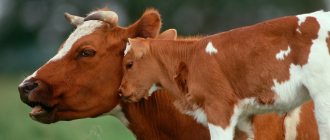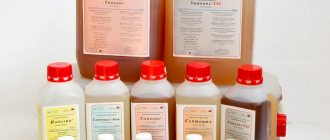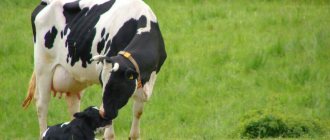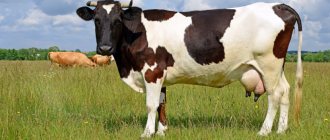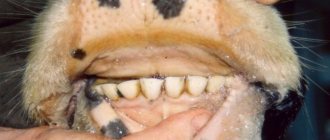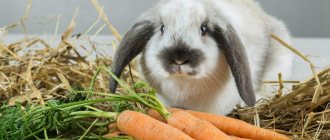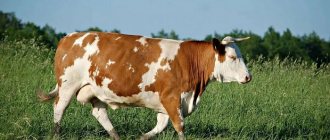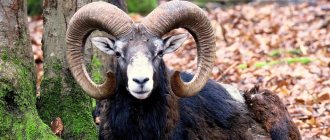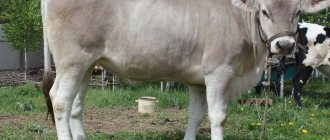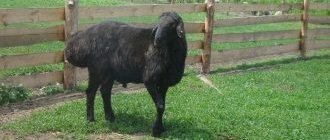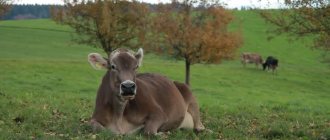If you are a novice livestock breeder and decide to buy a cow or goat for milk, then you should know exactly:
- how many teats do cows and goats have?
- what form they can be;
- how the processes are located;
- normal distance between them;
- correct nipple direction;
- udder diseases in these dairy animals;
- how all these indicators affect the quality and quantity of milk produced.
Studying the structure of the udder of a particular cow is very important when choosing an animal
Quantity and shape
For farmers who produce milk on an industrial scale, this issue is fundamentally important, since to milk cows they use a special milking machine consisting of 4 bowls. Cows have different numbers of teats:
- 3—abnormal unwanted quantity.
- 4 is the standard number.
- 5-6 is an abnormal amount. Accessory teats are usually located on the back of the udder, between the main teats, next to or directly on them. These additional processes can be different: underdeveloped or with their own mammary gland. They are not the norm, as they can provoke the development of a disease such as mastitis. Their appearance is facilitated by genetic predisposition.
Abnormalities in the number of nipples are very rare in goats; the standard number is 2.
The way the nipples look is also very important when choosing a dairy animal. A few words about this:
- Cylindrical. Considered preferable.
- Conical. Also preferred.
- Bottle shop. Acquired during life, not genetically transmitted.
- Pear-shaped. Acquired during life, not genetically transmitted.
- Pencil-shaped. Unchangeable hereditary form.
- Funnel-shaped. Unchangeable hereditary form.
How the udder works
In general, there is a distinction between the classic structure of a cow’s udder and the abnormal one. True, in addition to this, there are also options for small deviations that do not affect productivity, but more on that later.
A normal organ consists of two main oblong lobes, which are located to the right and left of the longitudinal axis. In turn, each of the shares is also divided into 2 halves, but this time across. Thus, the udder is divided into 4 sectors, which are usually called quarters.
The structure of the mammary gland in a cow is sectoral. The tissue that forms the shell of these sectors is called stroma; it performs a supporting function, plus blood vessels are located there.
The body of the udder is called parenchyma. There are several types of tissue in the parenchyma, but the main one is the glandular epithelium, which actually produces milk. The remaining tissues perform auxiliary functions, such as stimulation and transportation.
At the bottom of the udder there is a so-called tank for collecting milk. And from this tank the final product flows through channels into the papillae. To prevent milk from flowing out, there is a locking muscle (sphincter) on each papilla.
Udder Features
Studying the structure of the udder of a particular cow is very important when choosing an animal and implies, first of all, studying its shape. Cows have udders:
- Bath-shaped. The most spacious, since the length and width vary greatly. Long, wide and deep.
- Cup-shaped. Round and deep udder. Very roomy.
- Rounded narrowed.
- Goat. So called because of the underdeveloped front nipples and drooping rear ones.
- Primitive underdeveloped. In the form of a hemisphere with small nipples that are located very close.
With well-developed mammary glands, a cow's milking glands are located at approximately equal distances and form something like a square.
The shape of a cow's udder changes throughout its life. Factors on which this depends:
- age indicators;
- the presence or absence of a lactation period (the udder increases in size and changes its shape until lactation 5-7);
- pregnancy;
- the degree of milk filling, which depends on the intervals between milkings, nutrition, and care.
Capacity Definition
Milk is constantly produced in the mammary glands, and is excreted during milking or feeding the calf. After filling the alveoli and small ducts, the milk secretion accumulates in the cistern. Intraudder pressure affects the capacitance characteristics of the udder. The tone of the walls and the amount of milk depend on the pressure.
When the pressure in the capillaries is compared with the intraudder pressure, the process of milk formation stops.
Highly productive cows fill the tanks to 90% 12 hours after milking. The large organ allows you to increase the time between milkings without reducing the amount of milk produced. The maximum one-time milk yield depends on the capacity of the tanks and the age of the cow. Capacity is determined according to the following table:
| Indicators | Cow age (lactation) | ||
| 1 | 2 | 3 or more | |
| Daily milk yield, kg | 15,0 | 21,66 | 23,64 |
| Tank capacity, kg | 8,71 | 12,27 | 13,74 |
| Tank Filling (%) | 56-58 | 56-57 | 58-59 |
With frequent stimulation of the nipples, oxytocin is produced, the pituitary gland is stimulated, and hormones are released that trigger the milk production process. Proper feeding during triple milking allows you to increase milk yield:
| Daily milk yield, kg | Increase in milk,% |
| 10 | 3-5 |
| 15-20 | 7-8 |
| 25-30 | 20-30 |
Nipple location
With well-developed mammary glands, the cow's nipples are located at approximately equal distances and form something like a square. If there are fat deposits in the udder, then the teats gather in a bunch.
The location of a cow's nipples can be:
- wide and creating a square shape;
- wide set front and close rear;
- close lateral, right and left at a normal distance;
- all close.
The optimal distance between a cow's teats should be:
- the ends of the anterior processes are 15-18 cm;
- ends of rear milkings - 6-10 cm;
- the anterior and posterior ends of the nipples are 8-12 cm.
Important! The skin on the nipples should be smooth. Pronounced vessels and veins (they are called milk veins) on the organ indicate good circulation of milk, which contributes to good milk yield.
The udder of a goat depends entirely on the age of the animal.
The directions of the nipples can be very diverse:
- vertical;
- slightly inclined forward;
- strongly tilted forward;
- in different directions.
Features of the location of the nipples of a goat:
- close to the front;
- directed upward;
- directed downward.
Producing the highest quality milk
The main factor that underlies the production of a good product from a dairy cow is maintaining the cleanliness of the udder and teat area.
When cows lie down on the floor, the udder is subjected to a massive attack by various microorganisms, such as staphylococci, streptococci, paratyphoid bacteria, various putrefactive microorganisms and others. If you do not wash the udder before milking, they will certainly end up in the cow's milk.
Some pathogenic microbes are very dangerous to humans. In addition, the product quickly deteriorates, acquires a bad taste and unnatural consistency.
Important! When microbes enter the internal structural components of the udder, various diseases develop that adversely affect the quantity and quality of milk.
Particular attention should be paid to the hygiene of workers who milk cows. Their hands are carriers of a huge number of pathogenic microbes.
Due attention should be paid to the use of clean towels and disinfectants when washing the animal's udder.
Some microorganisms are resistant to high temperatures, so even boiling and pasteurization will not save them if they get into milk.
Based on the above facts, we can draw conclusions about how important basic hygiene rules are for the quality characteristics of milk and the health of people and cows.
Breast diseases
Sickness necessarily affects milk yield, so the health of the cattle must be taken seriously. At the slightest sign of illness, take immediate action.
Udder diseases in cows:
- mastitis;
- swelling;
- injury;
- furunculosis;
- papillomas;
- milk incontinence;
- slowness.
Udder diseases in goats are divided into several main groups:
- non-contagious, arising from improper feeding;
- parasitic, which occurs when foreign creatures appear in the body;
- infectious.
To avoid advanced diseases, it is necessary to perform the following procedures every day to help detect the disease and cure it:
- thorough washing;
- massage;
- lubrication with oil or grease.
Edema
This disease mainly occurs in the first time after the birth of a calf.
Edema is characterized by a long period required for healing. Sometimes this period extends to several months.
Swelling in the udder can be a harbinger of more serious diseases of the heart and genitourinary system.
Causes:
- laying down during the launch period before calving;
- urinary tract infections;
- an excess of succulent feed in the diet;
- udder damage.
Symptoms:
- coldness of the skin of a specific area of the nipples;
- deterioration in the quality characteristics of milk;
- increasing the size of individual sections of the udder;
- visual shortening of the nipple on the swollen lobe;
- change in skin structure.
Treatment:
- transfer to drier food;
- limiting fluid intake;
- increasing the time allotted for walking;
- increasing the number of procedures for expressing milk up to 10 times a day.
Anatomy of a cow
When buying a cow, many people mistakenly pay attention to the volume of the udder, counting on a direct relationship between a large udder and high milk production, since it contains a huge layer of fat. And milk is produced thanks to the glandular mass contained in it. Moreover, the number of shoots is also not a guarantee of the desired milk yield. How many should a cow have? What are their anatomical characteristics? When does a cow give the most milk?
First, let's look at the cow's udder , it comes in 5 forms:
- Bathtub-like udder. This udder is very capacious, since the distance between length and width is about 15 percent;
- Bowl shaped. This udder can also be called deep and round;
- In the shape of a narrowed circle with the nipples close to each other;
- Resembling the shape of a goat's udder, it is distinguished by underdeveloped anterior nipples and drooping posterior parts, delimited by a furrow;
- Underdeveloped with small and closely spaced shoots.
How many teats does a cow have?
When milking by hand at home, the number of milkings in a cow and horse is absolutely not important; however, on farms they use a milking machine designed for four shares.
Basically , each cow and horse has four teats , but there are also individuals with five or even six teats. Additional teats can be seen on the back half of the udder, they are located near the regular teats, and in rare cases - on the teats themselves. In some cases, these accessory organs are perfectly developed, sometimes they are underdeveloped and therefore do not function at all.
Many years ago, it was believed that additional shoots were evidence of excess milk supply. It has now been established that additional glands are a major risk for the development of mastitis, a terrible disease. Rarely, additional processes grow together with the main organs; as a result, the cistern of the process and canal narrows, resulting in poor milk production.
Multiple nipples have an undesirable property - hereditary transmission from generation to generation. Farmers who breed cows select cows with special care to avoid inbreeding.
Note that some cows have only three teats, this is an abnormal phenomenon.
Location of nipples on the udder
In accordance with the peculiarities of the location of the processes:
Square arrangement , that is, the nipples are located at an equal distance from each other;
- The front nipples are spaced wide apart, and the rear ones are close together;
- Close distance between the lateral nipples;
- Very close nipples.
When using a milking machine, close organs (closer than six centimeters) are exhausting work, since it is difficult to put on milking cups in this situation. At the same time, the large distance between the front nipples (more than 20 centimeters) also causes a lot of inconvenience, since there is a bending of the glasses due to gravity, as a result of which the process of milking slows down. Let us denote the best distance between the processes:
- Anterior nipples – 15–18 centimeters;
- The ends of the rear nipples are 6–10 centimeters;
- The anterior and posterior ends of the nipples are 8–12 centimeters.
Cow udder shape
The udder of a cow changes throughout its life, which is associated with several factors: 1) age characteristics, 2) lactation period, 3) pregnancy, 4) fullness of milk.
Two to three months after calving, the development and enlargement of the mammary glands is observed, gradually the size decreases and lactation capacity decreases. Up to the fifth or seventh calving, the udder will change, and then it begins to age altogether, losing its elasticity and its previous shape.
Goat care
A warm, dry, ventilated room without drafts is an ideal place to keep a goat. Udder care is especially to prevent the occurrence of various diseases.
Prevention of udder diseases is thorough milking before each period of lactation, including massage. Massage movements improve blood circulation, improve the taste of milk and increase milk yield.
to avoid udder diseases in goats . When the kids are still very small, they are milked 4–5 times; gradually, as they begin to grow, milking is reduced to 2–3 times a day. After milking, it is necessary to wipe with a dry and clean cloth and lubricate with oil.
Appearance
The overall anatomy of the goat and cow can also determine the amount of milk you get.
Features of the appearance of a good milk cow:
- body angular;
- wide pelvis;
- tucked belly.
The structure of a goat, indicating its health and good milk yield:
- good teeth that show age;
- poorly developed muscles;
- angular body shape.
The healthy development of small cattle directly depends on how correct the structure of the milk organ is.
People who are far from animal husbandry believe that a large udder of a cow, or as amateurs put it, “serious size of boobs,” indicates the high productivity of the animal. In reality, the external dimensions of the udder are not a sign of high or low milk yield. Let's look together at the anatomy of this important organ. Plus, you will learn how many teats a cow should have on her udder, how they are located, and what the productivity of dairy cows actually depends on.
Proper care
Proper care of a cow's udder is deservedly considered the key to high milk yields. You can buy a “golden” cow and with a rude, unprofessional approach to the cow’s udder “multiply by zero” the probable profit.
The udders are massaged for both dairy and meat cows; if in the former this leads to an increase in milk yield, then in beef cows after the massage they calm down and give fattier milk, which is important for calves and for weight gain.
Fortunately, the procedure for massaging a cow's udder is not complicated. The massage is performed with both hands, with soft and smooth movements. Begins and ends with stroking. Usually the whole process takes 30 – 40 seconds. Do not forget that before and after milking the udder must be washed and wiped dry.
There is one more point regarding care - it is strictly forbidden to remove the milking cups from the teats until the vacuum is turned off. Just as you can’t keep a vacuum on a milked udder for a long time.
As practice shows, quite often novice breeders are negligent about the udder of cows. If you liked the article, share it with your friends and your like can save beginners from making mistakes and ease the suffering of little cows.
- Author: Maria Sukhorukikh
Rate this article:
- 5
- 4
- 3
- 2
- 1
(0 votes, average: 0 out of 5)
Share with your friends!
